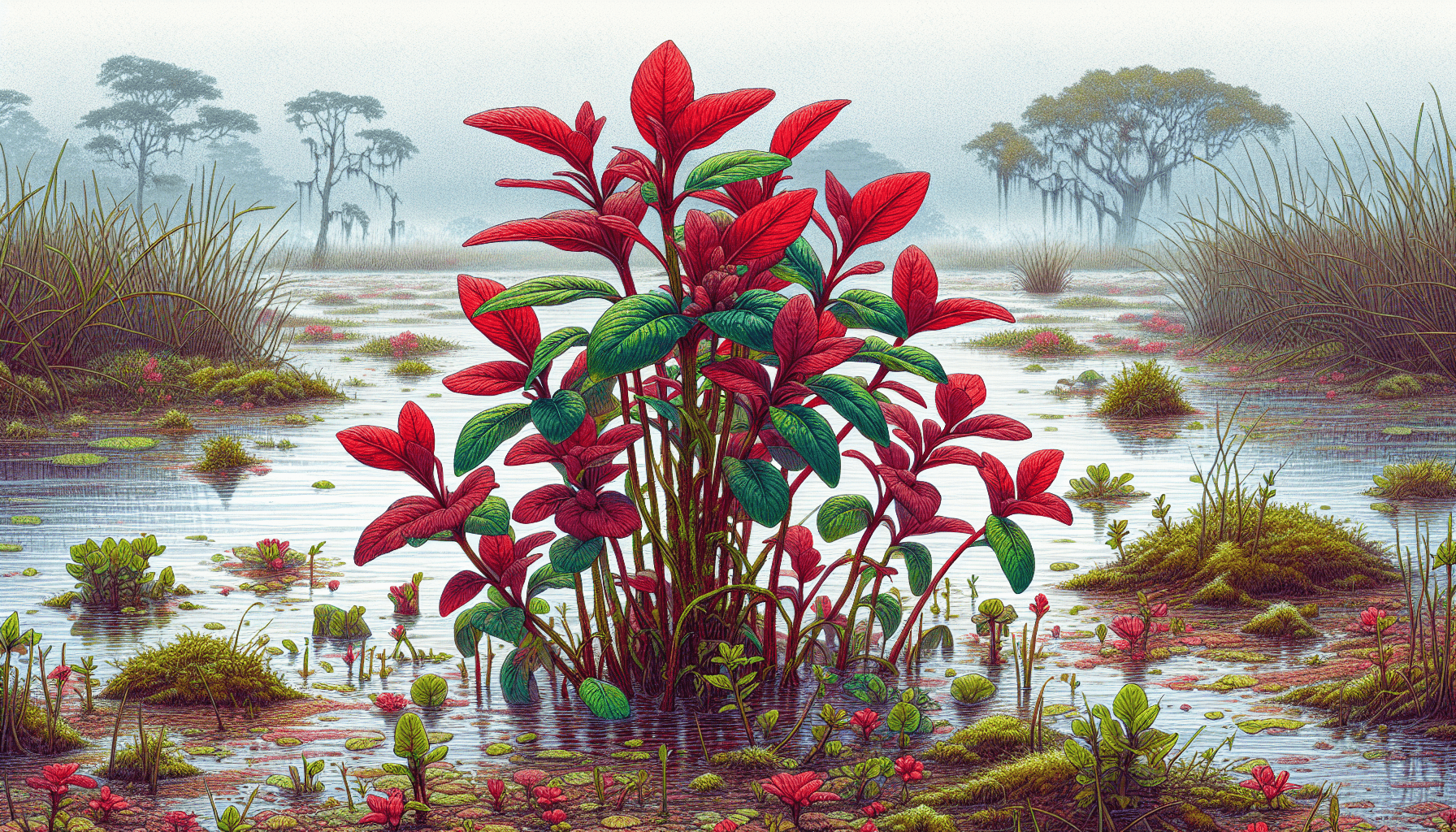In this article, attention is drawn to Ludwigia Inclinata, an aquatic weed of considerable importance. You will find comprehensive insights into the characteristics, habitat, growth patterns, and ecological significance of this unique species. This aquatic plant, often considered a weed, plays a crucial role in the ecosystem it inhabits and offers an intriguing study into plant adaptability and survival. The ensuing discourse hopes to bring about an understanding of this underwater flora and its impact on both local and global water bodies.

Identifying Ludwigia Inclinata
Ludwigia inclinata is an aquatic plant that is categorized as a weed due to its invasive nature. Although this plant is often sought after by hobbyists for its unique and vibrant colorization and its adaptability in various aquatic environments, it is important to identify this species correctly to manage its growth effectively.
Physical characteristics
One of the main physical characteristics that set Ludwigia inclinata apart from other aquatic plants is its distinctive leaf shape. It sports small, pointed leaves that are usually red or green depending on its exposure to light. As light intensity increases, the leaves turn more reddish while they turn green under low light conditions. Its stems, growing tall and slender, can reach up to 30 inches in length, depending on its growing conditions.
Varieties of Ludwigia Inclinata
There are several varieties of Ludwigia inclinata, including Ludwigia inclinata var. verticillata ‘Cuba,’ Ludwigia inclinata var. ‘Pantanal,’ and Ludwigia inclinata var. ‘Diamond.’ Each variety possesses unique characteristics and can differ slightly in growth habits and leaf coloration.
Natural habitats
Ludwigia inclinata is a species native to Central and South America. It typically thrives in standing or slow-moving waters, which makes it a common resident in ponds, swamps, and streams.
Reasons for Ludwigia Inclinata being categorized as a weed
The classification of Ludwigia inclinata as a weed principally stems from its growth patterns and its disruptive influence on aquatic ecosystems.
Rapid growth rate
Ludwigia inclinata grows rapidly under optimal conditions. It quickly forms dense mats on the water’s surface, which shades the water substantially and reduces the light accessible for other submerged aquatic species.
Invasiveness
By nature, Ludwigia inclinata is highly invasive. It multiplies rapidly through both seed and stem propagation, allowing it to quickly colonize new areas.
Impact on native species
When Ludwigia inclinata becomes invasive, it leads to a drastic decrease in native species’ biodiversity. Its high reproductive rate and aggressive growth allow it to outcompete native aquatic plants.
Difficulty in controlling and eliminating
Ludwigia inclinata is notorious for its resilience. Its ability to regrow from fragment makes it extremely challenging to control and eliminate, contributing further to its classification as a weed.
Ludwigia Inclinata in Aquascaping
Ludwigia inclinata, despite being considered a weed, is a popular choice in the world of aquascaping due to its aesthetic appeal and versatility.
Utilization of Ludwigia Inclinata as ornamental plant
Utilized for its vibrant coloration and unique leaf structure, Ludwigia inclinata adds variety and depth to the design of an aquarium. It often serves as an accent piece within an aquascape, adding vertical height and richness in color.
Special care and maintenance requirements
While Ludwigia Inclinata is easy to grow, it still requires special care to lush and vibrant. It demands high light levels, CO2 injection, and a nutrient-rich substrate. Regular pruning is likewise necessary to prevent it from overshadowing other plants.
Suitable setup and environments
Ludwigia inclinata is flexible and can thrive in various setups. It can tolerate a wide range of water parameters, though it prefers slightly acidic and warm conditions.

Ecological Impact of Ludwigia Inclinata
The spread of Ludwigia inclinata in natural habitats can result in several negative ecological impacts.
Impact on water quality
Dense growth of Ludwigia inclinata can create a figure that impacts water quality. It obscures light penetration, altering temperature and oxygen levels, which can affect other aquatic life forms.
Influence on local fauna
The proliferation of Ludwigia inclinata can affect local fauna by altering their habitats. It provides little food value for most local fauna and can interfere with their foraging activities.
Interference with recreational activities
Not only does Ludwigia inclinata impact ecosystems, but it also interferes with recreational activities. Dense mats of Ludwigia inclinata can hinder boating, fishing, and swimming in infested areas.
Methods of Ludwigia Inclinata Propagation
There are various methods that Ludwigia inclinata employs to ensure its spread and continuance.
Sexual reproduction
Ludwigia inclinata breeds by producing numerous small seeds housed in a capsule. These seeds readily germinate in favorable conditions.
Asexual reproduction
Apart from seed propagation, Ludwigia inclinata also exhibits the ability to clone itself asexually. This capability makes it very resilient; even a small fragment can grow into a new plant.
Human-induced propagation
Human activities commonly introduce Ludwigia inclinata into new areas. It’s often unintentionally spread via boating equipment or deliberately planted for decoration.
Strategies for Ludwigia Inclinata Control and Management
Effective control and management strategies can prevent or slow the spread of Ludwigia inclinata. These include manual, chemical, and biological methods.
Manual methods such as hand-pulling or cutting
Manual methods involve physically removing the plant from the water. This can be an effective way to reduce Ludwigia inclinata populations if done regularly. Hand-pulling and cutting require careful handling to prevent plant fragments from falling back into the water.
Chemical control using herbicides
Herbicides offer an effective control measure against Ludwigia inclinata. However, they must be used judiciously due to their potential impact on non-target species and the environment.
Biological control via herbivorous fish
Biological control introduces a natural enemy to reduce Ludwigia inclinata populations. Herbivorous fish, such as the grass carp, can consume Ludwigia inclinata and thus limit its growth.
Legislation Relating to Ludwigia Inclinata
Regulations have been implemented internationally and nationally to limit the spread of Ludwigia inclinata due to the detrimental effects it can have on local ecosystems.
International regulations
International regulations exist to restrict the trade and transport of Ludwigia inclinata. These regulations aim to curb the spread of this invasive weed into new habitats.
National restrictions in different countries
Various countries have established their own restrictions on Ludwigia inclinata. In some countries, it is illegal to plant, sell, or even possess Ludwigia inclinata without a permit.
Recommendations for hobbyists and plant enthusiasts
Hobbyists and plant enthusiasts should consider the potential environmental impacts of Ludwigia inclinata and take steps to prevent its spread. This includes avoiding dumping aquarium plants in natural water bodies and taking care to properly dispose of plant materials.
Case Studies on Ludwigia Inclinata Infestations
Documented cases of Ludwigia inclinata infestations offer crucial insights into the plant’s destructive potential and offer sustainable management solutions.
Reports from different regions worldwide
Ludwigia inclinata infestations have been reported in different regions worldwide, attesting to the plant’s invasive potential. Each region offers unique lessons about the plant’s behavior and impact.
Efforts on eradication and control
Many agencies and stakeholders have tirelessly worked on eradicating and controlling Ludwigia inclinata. Often, it requires a multi-pronged approach that includes public education, early detection, and rapid response.
Lessons learned and best practices
The struggle against Ludwigia inclinata infestations has led to the identification of best practices in weed management. These include community awareness, coordinated control efforts, and targeted research for particular control methods.
Research on Ludwigia Inclinata
Prominent research has been conducted on Ludwigia inclinata, focusing on its growth rates, ecological impacts, and innovative control and management techniques.
Studies on its growth rates
Numerous studies have scrutinized Ludwigia inclinata’s growth rates across different environmental conditions. Understanding these rates helps predict its invasive potential and devise effective control methods.
Research on its ecological impact
The ecological impact of Ludwigia inclinata has been a significant area of research. Studies have revealed how this weed alters local ecosystems and impacts biodiversity.
Innovation in control and management methods
Research has also focused on innovating control and management methods for Ludwigia inclinata, particularly developing eco-friendly methods that have minimal impact on non-target species and the environment.
Climate Impact on Ludwigia Inclinata
Climate plays a pivotal role in the spread, growth, and survival of Ludwigia inclinata.
Tolerance to differing temperature ranges
Ludwigia inclinata has a broad temperature tolerance, explaining its ability to survive in diverse climates and geographical locations worldwide.
Response to seasonal changes
While Ludwigia inclinata reacts well to warm temperatures, it shows lower resilience to cold conditions. During the cold season, it often dies back, only to regrow rapidly as the weather warms.
Potential spread due to climate change
Due to its heat tolerance, Ludwigia inclinata poses a higher risk of spreading in a warming world. Climate change might enable this weed to colonize newer areas, exacerbating its invasive potential globally.